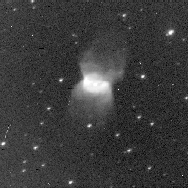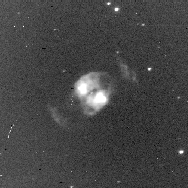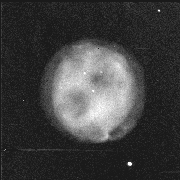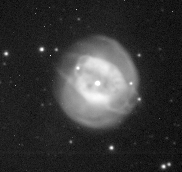 This is NGC 2346. It belongs to the class of bipolar planetaries
exhibiting "butterfly" or "hourglass" morphologies. Typically, these
nebulae come from somewhat younger stars than rounder planetaries.
This is NGC 2346. It belongs to the class of bipolar planetaries
exhibiting "butterfly" or "hourglass" morphologies. Typically, these
nebulae come from somewhat younger stars than rounder planetaries.
 This is NGC 2346. It belongs to the class of bipolar planetaries
exhibiting "butterfly" or "hourglass" morphologies. Typically, these
nebulae come from somewhat younger stars than rounder planetaries.
This is NGC 2346. It belongs to the class of bipolar planetaries
exhibiting "butterfly" or "hourglass" morphologies. Typically, these
nebulae come from somewhat younger stars than rounder planetaries.
 This is NGC 2371, which also has an obvious bipolar appearance. Note the
pair of faint "polar caps" to the upper right and lower left which
represent polar outflows, probably due to stellar winds constrained
by the equatorial torus.
This is NGC 2371, which also has an obvious bipolar appearance. Note the
pair of faint "polar caps" to the upper right and lower left which
represent polar outflows, probably due to stellar winds constrained
by the equatorial torus.
 This is NGC 3587, also known as the "Owl Nebula". The morphology pattern
is less obvious than for other nebulae on this page. Any suggestions?
This is NGC 3587, also known as the "Owl Nebula". The morphology pattern
is less obvious than for other nebulae on this page. Any suggestions?
 This is NGC 6804, which exhibits some evidence of an interaction with
the interstellar medium, along with a characteristic central torus
and outer halo. It may be similar to NGC 2371, but older and with a
less constrained wind.
This is NGC 6804, which exhibits some evidence of an interaction with
the interstellar medium, along with a characteristic central torus
and outer halo. It may be similar to NGC 2371, but older and with a
less constrained wind.
Author: George Jacoby